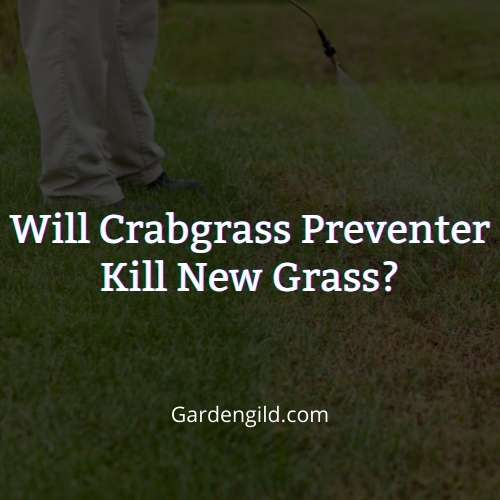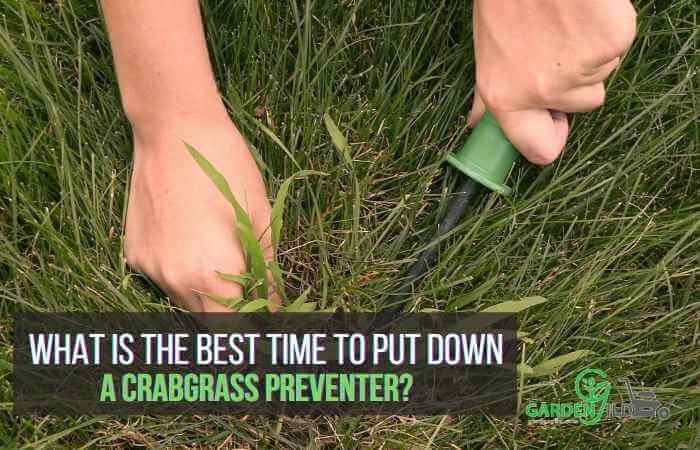A little investment like crabgrass preventers can take your whole gardening to the next level. As you are bound to get rid of the weeds that harm and occupy your lawn, you’ll need them the most.
But, along with the seamless merits, the crabgrass preventer equally comes with various demerits. Most of them are linked with their action of killing seeds.
With that being said, people like to investigate, will crabgrass preventer kill new grass?
Yes, a crabgrass preventer will kill the seeds of all new grasses if the correct application time is not maintained. Crabgrass preventer does not discriminate amongst any of your garden’s plants and therefore killing them. So they should be applied after 10-12 weeks of seeding.
A clear article about the topic is as mentioned.
In this garden gild guides we’ll discuss the following:
- How long after seeding can I use crabgrass killer?
- Does pre-emergent kill new grass seed?
- What is the best crabgrass killer for lawns?
- What is the best time to put down a crabgrass preventer?
- Can you put the grass seed down after pre-emergent?
- FAQs

Will crabgrass preventer kill new grass?
Crabgrass preventers are made to be used to prevent your lawn from crabgrass infestation. But, while doing so, they can also end up harming other plants in your garden, thus killing the new grasses as well.
Crabgrass is an unwanted element that ruins the look of your garden, along with making many indirect losses. Unfortunately, they are stubborn when it comes to the fact of getting rid of them.
Once you find traces of crabgrass on your lawn, you’ll have to be used to them for the rest of the years. That is to say, despite being seasonal weeds, you cannot get rid of them in a single season. Instead, they will die in winter and appear again in the following year at the very same season of their growings.
These problems can be obstacles in your path unless you take some severe initiatives like executing a crabgrass preventer.
A crabgrass preventer will work best to help you in closing this matter. But only by applying a preventer, you must not expect the best result until you follow the proper timings.
Besides the best result, their proper timing execution is also needed to save the other plants in your garden.
With that being said, it becomes clear that crabgrass preventers kill the crabgrass and kill all other plants that come in their contact.
So, the new grass you want for your garden and desire to grow can be killed by the preventers if proper measures are not followed.
That includes the too early seeding of the new grass after the application of those crabgrass preventers. The fresh grass can also get killed if a specific time is not maintained after the seeding application of preventers.
How long after seeding can I use crabgrass killer?
To follow the proper instructions and timing of the application of crabgrass killers, you need to first know about its consequence.
Crabgrass killers are widely used in the fields by the mean of killing weeds of crabgrass. But, while doing so, a common problem always arises. This problem is quite similar to that of the topic we are discussing right now.
While preventing crabgrasses from your lawn, you may also spot some reductions in the growth of your garden’s other plants. These plants are not the older ones that are existing on your lawn for quite a long time. Instead, these are the newly planted plants whose fate doesn’t allow them to be grown as a matured plants.
Crabgrass preventer doesn’t differentiate between any species of plants while performing their action. As a result, the same thing can also happen to the other plants, which is caused to the crabgrasses.
All sorts of plants that include grasses, weeds, flowers, leaves, trees, and other gardening plants, can be the targets of a crabgrass preventer.
But, the thing that should be kept in mind is that these preventers do not impact the existing matured plants of your garden. They only play with the seeds and affect the natural process of seeding.
As a result, the new grasses or other new plants are on the side of more significant impact due to their untimely seeding in the lawn.
This brings us the proper timing of seedings and the perfect periods after which the application of preventers should be executed after seeding.
After a time of 12-16 weeks, you can put crabgrass preventers on your lawn because the average timing for most of your plants to germinate and produce seedlings from the seeds is between this range.
When the seeds get complete with their action, it becomes the right time for you to play with your preventer and get rid of those wicket weeds.
In this way, both the desired grasses and plants will be saved and prevent wild weeds.
Does pre-emergent kill new grass seed?
For your ease of interpretation, almost for most cases, pre-emergent is used as the best crabgrass preventer for your lawn. Which further needs no require of telling that, they also kill the new grass seeds of your garden.
Pre-emergent raise battles against all those newly sown seeds that are on the way to sprout. This includes almost all the plants that remain in an immature state on your lawn. By the immaturity, it is meant by the early growing stage of saplings from the seeds.
Along with the positive sides, a pre-emergent can also be a reason for your waste of time, money, and effort as they can end up killing hard gains or, therefore, hampering the seeds of your new desired grass.
When you hurry in getting rid of the weeds and increasing the thickness of your lawn at the same time, you become reasonable will killing the new grasses.
As new cultivable desired grasses upgrade your gardens, you may want to fill your garden with them as soon as possible. This can drag you into the biggest mistake.
The mistake is most often linked with the seedings of those new grasses within less than 12 weeks after the execution of the pre-emergent.
It would help if you didn’t forget that pre-emergent remains active for about 8-22 weeks. So, within this time, no seeds on your lawn can escape from them.
To avoid the death of your new grass’s seeds, you need to highly prevent their seeding within this time range.
What is the best crabgrass killer for lawns?
The all-time best and a widely used crabgrass killer cannot be anything else other than a pre-emergent. Pre-emergent not only eradicates the crabgrass but also equally kills all the new seeds in the garden within the general 8-12 weeks.
Pre-emergent are best as they create an invisible shield in between the seeds and the surface of the soil on your lawn. As a result, when roots try to grow through the surface during the germination period, this shield puts an obstacle in their path.
A proper dosage of the pre-emergent can turn out to be the best preventer of crabgrass. They should be applied as the first dosage at the time of the growth of seeds. Then, again, the second dosage is done after 6-8 weeks of the first one.
What is the best time to put down a crabgrass preventer?
The timing for your crabgrass preventer application is divided into a variety of ranges. The best time for putting them down is the time at which the crabgrass grows per year.

To be straightforward, use your crabgrass preventer during spring when the soil temperature hits 13° Celsius for three consecutive days. At this time, the seeds will start to grow. At this exact moment, when you put down the preventers, all the bases are killed before germination.
Again, the preventers should be used, keeping in mind the new seeds of the desired grasses. The application should be restricted before and after 8-12 weeks of the newly seeded lawn.
Can you put the grass seed down after pre-emergent?
No, you should give some space to your lawn and pre-emergent so that they get enough time to lose their effectiveness and thus becoming eligible for your new seeds.
The perfect time for your pre-emergent application is after the late winter when they can stop the growing crabgrass.
And, the best time at which you should put down the seeds is in the fall. During this time, all the crabgrass will die, and the effect of the pre-emergent will also end, thus making room for your new seeds to grow.
people also ask
1. How do you kill crabgrass in a newly seeded lawn?
Killing out the crabgrasses from your lawn is not as easy as just applying a crabgrass preventer. For getting rid of them, it is pretty logical to leave the preventers and let the rest of the jobs done by them. But that’s not it!
Proper timing matters a lot that plays like a game-changer bot for killing the weeds and saving the other newly plant seeds.
That is to say; you need to be careful with applying preventers in your newly seeded lawn. When you need to use the preventers, wait for around 16 weeks after the sowing of new seeds.
2. Does Scott’s crabgrass preventer kill new grass seed?
Yes, like most of the crabgrass preventers, Scott crabgrass preventer also kills new grass seeds along with all other available species.
The requirements for their use are all the same as the pre-emergent. They almost follow similar instructions. The timing of their application should also be after three months of the newly planted seeds.
Also Read:
Conclusion
Crabgrass preventers kill or hamper the growth of new grass. So, you need to be careful about applying it on your lawn. Try to find out the best time to apply it; this will surely help keep the lawn beauty intact.
